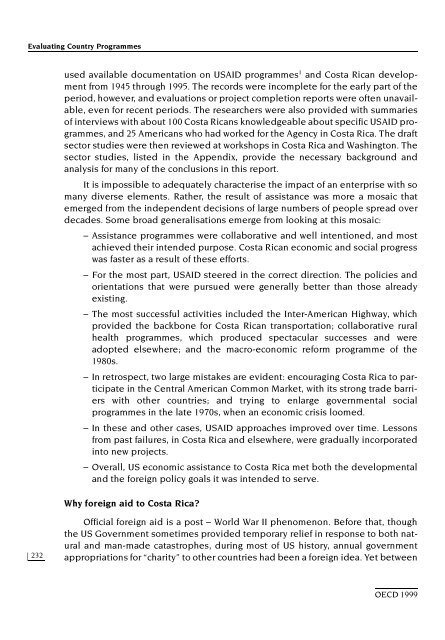Evaluating Country Programmes - OECD Online Bookshop
Evaluating Country Programmes - OECD Online Bookshop
Evaluating Country Programmes - OECD Online Bookshop
Create successful ePaper yourself
Turn your PDF publications into a flip-book with our unique Google optimized e-Paper software.
<strong>Evaluating</strong> <strong>Country</strong> <strong>Programmes</strong><br />
232<br />
used available documentation on USAID programmes1 and Costa Rican development<br />
from 1945 through 1995. The records were incomplete for the early part of the<br />
period, however, and evaluations or project completion reports were often unavailable,<br />
even for recent periods. The researchers were also provided with summaries<br />
of interviews with about 100 Costa Ricans knowledgeable about specific USAID programmes,<br />
and 25 Americans who had worked for the Agency in Costa Rica. The draft<br />
sector studies were then reviewed at workshops in Costa Rica and Washington. The<br />
sector studies, listed in the Appendix, provide the necessary background and<br />
analysis for many of the conclusions in this report.<br />
It is impossible to adequately characterise the impact of an enterprise with so<br />
many diverse elements. Rather, the result of assistance was more a mosaic that<br />
emerged from the independent decisions of large numbers of people spread over<br />
decades. Some broad generalisations emerge from looking at this mosaic:<br />
– Assistance programmes were collaborative and well intentioned, and most<br />
achieved their intended purpose. Costa Rican economic and social progress<br />
was faster as a result of these efforts.<br />
– For the most part, USAID steered in the correct direction. The policies and<br />
orientations that were pursued were generally better than those already<br />
existing.<br />
– The most successful activities included the Inter-American Highway, which<br />
provided the backbone for Costa Rican transportation; collaborative rural<br />
health programmes, which produced spectacular successes and were<br />
adopted elsewhere; and the macro-economic reform programme of the<br />
1980s.<br />
– In retrospect, two large mistakes are evident: encouraging Costa Rica to participate<br />
in the Central American Common Market, with its strong trade barriers<br />
with other countries; and trying to enlarge governmental social<br />
programmes in the late 1970s, when an economic crisis loomed.<br />
– In these and other cases, USAID approaches improved over time. Lessons<br />
from past failures, in Costa Rica and elsewhere, were gradually incorporated<br />
into new projects.<br />
– Overall, US economic assistance to Costa Rica met both the developmental<br />
and the foreign policy goals it was intended to serve.<br />
Why foreign aid to Costa Rica?<br />
Official foreign aid is a post – World War II phenomenon. Before that, though<br />
the US Government sometimes provided temporary relief in response to both natural<br />
and man-made catastrophes, during most of US history, annual government<br />
appropriations for “charity” to other countries had been a foreign idea. Yet between<br />
<strong>OECD</strong> 1999

















![CQE=U]^\]Z: KAZAKHSTAN - OECD Online Bookshop](https://img.yumpu.com/3915768/1/190x253/cqeuz-kazakhstan-oecd-online-bookshop.jpg?quality=85)